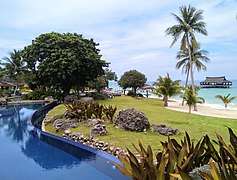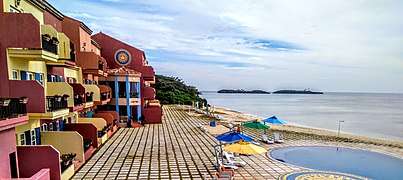Balesin Island
Balesin Island is a tropical island and barangay off the eastern coast of Luzon in the Philippines, 60 nautical miles east of Manila. It is located in Lamon Bay and is administered as part of the municipality of Polillo, Quezon.
 Beach at Phuket Village, Balesin Island Club | |
.svg.png) Balesin Island Location within the Philippines .svg.png) Balesin Island Balesin Island (Philippines) | |
| Geography | |
|---|---|
| Coordinates | 14°25′27″N 122°02′14″E |
| Area | 424 km2 (164 sq mi) |
| Highest elevation | 8.74 m (28.67 ft) |
| Administration | |
Philippines | |
| Region | Calabarzon |
| Province | Quezon |
| Municipality | Polillo |
| Demographics | |
| Population | 700 |
Climate
The weather of Balesin Island is dominated by the trade winds, creating two seasons. The amihan (northeast monsoon) brings moderate temperatures, little or no rainfall, and a prevailing wind from the east. Typically it begins in November or December and ends sometime in May or June. Throughout rest of the year, Balesin Island experiences the habagat (southwest monsoon) season, characterized by hot and humid weather, frequent heavy rainfall, and a prevailing wind from the west.[1] The island is periodically subject to severe tropical storms.[2]
History
Balesin island allegedly acquired its name from the local name for the banyan, balete, and the Tagalog word for salt (asin), reflecting the waters surrounding the island.[3] During the Japanese occupation of the Philippines, a contingent of seven soldiers lived on Balesin Island, reportedly existing peacefully with indigenous local fishermen and their families.
Development
After World War II, Balesin Island was bought by Edgardo “Ed” Tordesillas, who began to develop it with basic facilities for tourism. Early customers were predominantly Japanese. Today Balesin Island is a property of Alphaland Corporation,[4] a private company majority owned by its Chairman Roberto Ongpin,[5] a prominent Filipino businessman.
Transport to the island is by sea (approximately 4 hours from the Port of Atimonan) or by air (approximately 25 minutes flight time from Manila to Balesin Airport)
Around 10% of the island has been developed to create a luxury resort, Balesin Island Club,[6] with membership fees reportedly in the range ₱2.4-4 million.[7]
The resort was master-planned by EcoPlan of Miami, Florida to optimise ecological sustainability. Runoff from the 1.5 km runway of Balesin Airport provides over 100 million liters of water annually which passes through several man-made lakes and filtration to provide potable water. In addition used water is recycled for landscaping during the summer. The island's coral reefs are managed for diving and sustainable fishing with local species including parrotfish, butterfly fish, yellowfin tuna, mahi-mahi, grouper, and deep-sea crabs.[8]
 Beach outside the clubhouse at Balesin Island
Beach outside the clubhouse at Balesin Island Beach outside the clubhouse at Balesin Island
Beach outside the clubhouse at Balesin Island St Tropez Village, Balesin Island Club
St Tropez Village, Balesin Island Club
References
- "Philippines : Weather". Lonely Planet (travel guidebook).
- Pazzibugan, Dona (July 28, 2011). "Storm toll: 27 dead, 31 missing". Philippine Daily Inquirer.
- Balboa, Jen. "Balesin Island Club: Baring Balesin". Asian Traveler Magazine. Archived from the original on 2018-06-21. Retrieved 2018-06-21.
- Lowe, Aya (April 4, 2013). "Alphaland's Balesin grows to meet demand". Rappler.
- "Life in the fast lane". Retrieved November 28, 2017.
- "Balesin Island Club places 2nd in UN World Tourism excellence awards". Manila Standard. January 31, 2018.
- "The Price Tags of The Philippines' Most Exclusive Clubs". Esquire. April 3, 2017.
- Lanyon, Charley (October 28, 2012). "Hot spots: Balesin Island Club, the Philippines". South China Morning Post.
